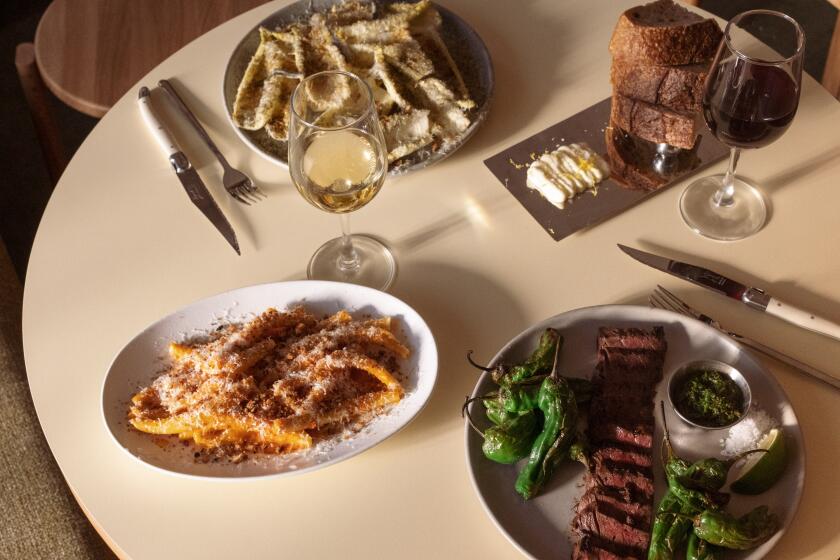The Rib Masters : The First Family of Barbecue
“I don’t smell it, I don’t see it, it can’t be barbecue.” --Woody Phillips
The night before he opened for business 18 years ago, Woody Phillips was a barbecue man without a sauce.
In the kitchen of his freshly painted barbecue shop, he gathered around him all the spices and seasonings he had bought in anticipation of the grand opening, and he began to cook. Adding and taking away different ingredients with every batch, he recorded every change with the pen and paper at his side, as if performing a laboratory experiment. His normal way of making sauce, a little of this and a little of that, would not do for the professional enterprise he was planning. This sauce, with which he hoped to make his fortune, would be cooked in 62-quart pots. He needed a formula.
Woody Phillips admits now: “I was scared to death.”
As a stubborn kid, one of the youngest in a family of eight, who refused to eat the leftovers that remained from dinner (which was mostly over by the time he came inside from doing chores on his family’s Louisiana farm), Phillips learned early on how to cook under pressure. His five sisters--”they were all larger than me,” he says--ruled the kitchen; they determined both what was eaten and when it was served. Young Woody’s revenge: he cooked himself better dinners than the ones his sisters had just eaten. “I would make the food so beautiful just to show them what I could do,” Phillips says. “I guess I rubbed it in--I come from a very competitive family.”
It was after midnight in the shop when Phillips had the ingredients just the way he wanted and set the brick-red sauce on the burner to cook a final time. He tasted the mixture after an hour. It wasn’t quite right. He tasted after another hour. It was better, but he decided to wait. By the third hour, it was 4 o’clock in the morning.
“I was thinking,” Phillips says, “‘This is performing more to my liking, but three hours, sheesh, that’s a long time and I’m getting really sleepy. I’ve got to be back here in the morning to open . . . what if I cooked it another half hour?’ ”
Finally, after 3 1/2 hours, he cut off the flame and took a spoonful. He liked what he tasted. “I said to myself, ‘This is good! And if the people who come here tomorrow agree with me, I’m going to call this sauce a gift from heaven.’ ”
Eighteen years later, Woody Phillips is talking about his gift--”I give credit to the good Man Upstairs,” he says--and he still cooks the sauce exactly 3 1/2 hours.
Foster Phillips, first cousin of Woody Phillips, was in high school back in Louisiana when he caught the barbecue bug. A teacher had invited a speaker, a brick mason who’d left his job one day and decided to build himself a barbecue pit.
“He told us that you could make a decent living in the barbecue trade, and that the work was good,” Foster Phillips says. “So I started teaching myself--we’d have barbecues at school and I’d experiment.”
It took Foster Phillips several years to act upon that initial inspiration. “My first dream was to be a surgical doctor,” he says. “But there were too many of us in the family, and we couldn’t afford college--I had to drop that in a hurry.”
He left Louisiana right out of high school with just $64 in his pocket, and ended up at the University of Pacific in Stockton . . . as a janitor. He took some classes at the local junior college, but soon had to get on with the business of making a living. He came to Los Angeles in 1961, where he eventually landed a decent-paying job as a machinist. That lasted 12 1/2 years.
But like the ex-mason who’d visited his high school, Foster Phillips knew he was destined for something more. He gambled everything he had on a tiny shop in an odd location, hidden in a parking lot near Crenshaw and Vernon, that many acquaintances said was sure to fail. That was nearly 13 years ago. “People know where to find good barbecue,” Foster Phillips says. “They look for the smoke.”
Earlier, Woody Phillips had come to a similar conclusion. He’d been involved in electronics, even worked on an Apollo project and helped come up with the blueprints for the instrument panel for the DC-10, but he’d gone as far as he could go in the field without going back to school for more training. “I was at a stopping point,” he says, “and I’d never seen a stopping point in my life. I wanted to be able to explode, to go as far as I thought I could go, rather than as far as someone else suggested.”
He worked up the nerve to talk to the owner of a Slauson Avenue barbecue stand that he knew was in trouble--he’d spent days at the doughnut stand across the street watching the flow of business--and eventually talked the proprietor into selling him the lease and the business for $3,500.
These days, you find the local barbecue crowd in dispute over which stand is better, Woody’s or Phillips. Waiting around for your order at either shop--there’s almost always a line at both places--you’ll occasionally hear the arguments in favor of one or the other: Phillips has better hot sauce, full of chile pods and seeds; Woody’s has better hot links, with more of a meaty taste and a real nice snap. No, no, says another, Phillips’ links are better, they’re softer. You mean mushier, the other responds.
The loyalties run so deep many customers assume Woody and Foster Phillips must not get along.
“Why is that?” Foster Phillips asks. “you’ve got McDonald’s and Taco Bell and Burger King sitting on the same block; there’s enough business for all of them. Same thing with barbecue.”
“Foster and I are very close,” Woody Phillips says. “We don’t even call each other cousin anymore--we’re brothers . And as far as No. 1 goes . . . I don’t believe in negativity.”
There are, of course, subtle differences in the way each approaches barbecue, but one thing is the same. Both are adamant about doing things the slow, old-fashioned way. They use oak-wood-burning ovens where the meat cooks in two stages, first closer down near the fire, then up higher after getting what both call a “marin-aise” (think of a combination between marinade and braise).
“I went into this partly because I thought barbecue was getting further and further away from what it should taste like,” Foster Phillips says. “I’d see people boiling their meat first, taking shortcuts with ingredients, using gas instead of wood.”
“Cooking the meat the right way, that’s where the barbecue is,” says Woody Phillips, “that’s where you get that good smoked taste. You don’t even need the sauce.”
“Barbecue is a tedious thing to master,” Foster Phillips says.
“It’s an art,” says Woody Phillips. “You have to feel what you’re doing. And when it’s done, you look at these beautiful ribs, this beautiful chicken, so succulent it’s flabbergasting, you can’t wait for the customer to try it. That’s when you know you’ve made what I call real, true barbecue.”
This sort of dedication does not go unnoticed in the community. Eating at Woody’s and Phillips is as much a cultural choice as a culinary one. Through the years, both have provided jobs for African-American and Latino workers. And during last year’s riots, both stayed open as long as they could--Woody’s running after dark on candlelight and oak--to maintain a sense of normalcy and to give people a place to get dinner in the neighborhood.
Foster Phillips, outraged at the violence, made up signs that read “black-owned” and distributed them to an Asian-owned cleaner and liquor store. “I look at it like this,” he says. “White, blue, black or green, we didn’t write God an application and tell him, ‘I want to be black, I want to be Chinese.’ You can’t go messing with God’s things.”
In the aftermath, Woody Phillips, who’d been donating extra food to a mission downtown, suddenly got noticed by the politicians. “They came on down and asked me, ‘Where’ve you been?’ I told them, ‘I’ve been doing. You’ve been talking.’ Here at my barbecue stand, I’m just doing my own thing, enjoying every minute of it and I don’t want to be put on a pedestal for it.”
More to Read
Eat your way across L.A.
Get our weekly Tasting Notes newsletter for reviews, news and more.
You may occasionally receive promotional content from the Los Angeles Times.










